Elegant and majestic lilies in the garden can become a bright accent in the landscape of the site for several years. This luxurious plant has a number of advantages that make it attractive for use in garden flower arrangements: slender stems, a wide palette of various shades of flowering, stunning aroma, bright large flowers, minimal need for care and resistance to pests and diseases.
The variety of lily varieties allows you to select plants taking into account individual stylistic preferences. The difference in the flowering periods of hybrid species makes it possible to arrange a flowerbed in such a way that it will delight and surprise for a long time with new shades and shapes of flowers.
Basic rules for planting lilies in the garden and their role in landscape design
The easiest way to plant a lily is to divide the bulb when replanting an adult plant. A more difficult planting option is to separate the bulbous scales. The optimal place for planting lilies is a small hill.
Rules for planting lilies
Rain and irrigation waters do not accumulate on the hill. You can create a slide yourself using slightly alkaline soil. If the soil is acidic, then add ash or chalk. In this case, you can make artificial drainage to protect the flowers from rotting roots. The depth of planting the bulbs depends on their size.
Lilies can be a strong allergen. The beauty of the garden should bring only positive emotions: people who are allergic to their flowering should not use these plants to decorate their garden.
When including this bulbous perennial in the design of a flower bed, the main emphasis is on its colorful and large flowers. A composition with lilies is created using the rules of color in landscape design.
When choosing flowers according to a combination of shades, focusing on the height of the stems and personal preferences in choosing the style of the flowerbed, do not forget that only plants with the same requirements for soil, lighting and watering can grow next to lilies. This means that they should love sunny locations, abundant regular watering and prefer fertile soil with good drainage.
Lilies respond well to mulching and the application of mineral nitrogen fertilizers. They do not like loosening and excessive soil moisture.
When creating a flowerbed, you need to achieve a harmonious composition. To do this, it is advisable to know in advance how the plants will look throughout the season and what care they will require. Lilies are decorative both before and during flowering. The bright green of the long leaves will be an excellent backdrop for shorter plants, and the blooms will complement the overall color palette of the flowerbed.
But after the flowers wither, a long peduncle remains, which cannot be cut off immediately. Therefore, when thinking through a floral ensemble, you need to decide how to hide plants that have lost their decorative effect.

This issue can be resolved by planting tall, broad-leaved flowers or shrubs nearby.
The color and shape of a lily flower depends on the variety. The color of the petals can vary from snow-white and soft lilac to orange-red and yellow. There are also varieties with very dark, almost black, flowers.
Lilies can be compact and not exceed 50 cm in height, or they can grow up to 2 m. These characteristics of the varieties must be taken into account when choosing the location of flowers in the flowerbed. Tall varieties of lilies will need support: this can be a decorative tree or a small carved column.
It will also be interesting: Caring for lilies - growing them in the garden in open ground ⚜
Five of the best flowers to combine with lilies
There are more than 100 species of different varieties of garden lilies in the world, all of them differ from each other in their size, flower structure, petal color and even aroma. When choosing friendly neighbors for lilies, you need to take into account the flowering time of these plants, their requirements for sunlight and humidity, the height of the flowers and the general color combination.
Check out five flowering plants that can harmoniously combine with lilies in a flower garden and maintain its attractive appearance throughout the summer season.
Phloxes
The most common garden species is paniculate phlox. It blooms at the end of June, the flowering is abundant, in the form of multi-colored fragrant caps. This plant is perennial and grows well, forming a herbaceous bush.

Phlox grows from 35 to 130 cm, the size of the bush depends on the sufficiency of sunlight
The perennial grows on loose and moist soils. For enhanced flowering, phlox needs regular feeding and good soil moisture - such agricultural conditions are also suitable for growing lilies.

Paniculate phlox can be red, purple, pink, white, lilac, but among them you will never see yellow specimens
Lilies in rich pink shades are planted next to paniculate phlox in lilac tones. Specimens of lilies with red or orange petals can look impressive next to white or pale lilac types of phlox.

Phlox will decorate a flower garden with lilies, protecting them from the summer heat, and will also decorate their stems after the end of the flowering period
Lilies and phlox go well together: they require regular watering, the height of their stems is approximately the same, and the flowering of these plants can be alternate - when the lilies fade, the phloxes bloom. Phlox varieties can be selected in such a way that they bloom throughout the entire summer period, taking turns replacing each other.
Delphinium
A perennial flowering plant with a tall stem and large, alternately arranged flowers. Delphinium grows as a bush and has a tendency to grow. The height of the plant, depending on the variety, can be from 45 to 130 cm.

In flower beds, delphinium is used as a soloist plant or combined with other tall specimens, for example, lilies
Features of arranging flower beds with lilies
In a flower bed with lilies, you can also plant other plants that tolerate abundant watering and sunlight. Another option for forming a flower arrangement would be to plant different varieties of lilies together. These can be annuals and perennials, tall and compact varieties that bloom in the spring or begin to bloom in mid-summer. All of these flower features can be used to determine how the flower bed will look throughout the season.
How to beautifully plant flowers in the foreground
Lilies of different varieties, planted in tiers, look good. In this case, low-growing flowers are planted in the foreground, which bloom in April. The next tier contains medium-sized varieties that will bloom in June, and the far tier is planted with tall varieties with late flowering.

Example of planting lilies
When combining lily varieties with other types of plants, you need to plant low-growing plants with small flowers in the foreground:
- Violets. These flowers are ideal for growing with lily varieties. They also like full sun and moist, well-draining soil. Their flowering begins in June and continues until frost. Depending on the variety, violets can be white, yellow or blue-violet. They grow from 10 to 45 cm.
- Primrose. It blooms all spring, but there are also summer varieties. It prefers cool soil, so it can be planted in the shade of lilies. The height of the plant is 15-45 cm. The colors of the flowers are varied: white, yellow, blue, red and purple.
- Thyme. Perennial spice. Its delicate pink flowers bloom in May and bloom throughout the summer. Before and after flowering, the decorative effect of thyme lies in the elegance of its lacy stems and leaves. A low-growing plant, the height of which does not exceed 20 cm, suitable for planting in front of any variety.
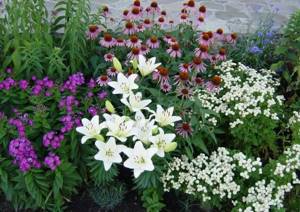
Combining lilies with other flowers
- Alpine aster. A low-growing perennial with delicate pastel flowers that appear in early summer. Like lily plants, aster loves sunlight and alkaline soil.
- Petunia. A perennial plant with a height of 15 to 50 cm. A palette of flowering shades: from white to purple and violet. Suitable for growing in open areas. Blooms from May to October.
- Calendula. An unpretentious and light-loving perennial with dense foliage and orange flowering, no more than 30 cm in height.
- Daisy. A perennial flower that grows up to 30 cm. It blooms all summer. Loves light and moist soil.
- Tagetes. Among the variety of varieties of marigolds, there are low-growing plants suitable for the foreground. Undemanding to soil and light-loving species. Blooms from mid-summer to late autumn. The color of the flowers is bright orange.

Tall varieties can be fenced around the perimeter with boxwood or other low bushy plants, including flower trunks.
Making a daylily
If you plan to create a daylily, then the following varieties are suitable for planting in the foreground:
- yellow Buff Pixtie;
- bright orange Contagem;
- pink with white border Angelique;
- snow-white with bright yellow stripes and scarlet anthers Auratum;
- soft lilac Crossover;
- pastel with yellow centers Lady Like;
- coral with a narrow white border Magny Cours;
- dark lilac Miss America;
- wavy pink Miss Germany
- snow-white New Wave;
- pink Pink Pixie;
- dark lilac Showwinner;
- pale pink Souvenir;
- dark purple with white spots Tiny Padhye;
- pink narrow-leaved Tiny Spider.

The first row of a mixture of low-growing varieties looks interesting and bright in the flowerbed.
When choosing flowers, you need to focus on their flowering time. Planting is planned so that plants flowering at the same time form a harmonious composition. Another win-win option for a flowerbed composition could be planting low-growing plants with decorative wide leaves in the first row.
It will also be interesting: Flowers similar to lilies - description, types and names ⚜
Lilies in the garden
Lilies are flowers that have a bright and original appearance. Thanks to this, the plants look great in flower beds or mixborders. In addition, they often make up special flower beds - daylilies.
Flowerbed arrangement

In order for a flower bed with lilies to look harmonious, you need to decide in advance what flowers will be combined with them. For example, you can plant tulips and daffodils along the edge of the composition. Delphiniums, daisies and asters will look good between the bushes. Alyssum, low marigolds, and garden carnations will be a good background for blooming lilies.
Most types of lilies prefer to grow in light partial shade, and therefore the flowerbed can be placed next to evergreen trees and shrubs. These include junipers, thuja, fir, and boxwood.
Combination with other colors
When choosing flowers suitable for planting in the same flowerbed with lilies, you need to take into account their flowering period, the size and shades of the plants, as well as their agricultural technology. There are no strict rules regarding this choice, and therefore each gardener makes it independently, based on personal preferences.
The combination of lilies with the most popular garden flowers:

- Phloxes. Design experts believe that tall plants with lush flowers do not go well with the majestic lily, but trailing varieties are ideal for such a neighborhood. In central Russia, some types of phlox bloom already at the end of spring, and after flowering ends they serve as an excellent decorative background, thanks to their leathery leaves. In autumn, the foliage of these plants can be used as mulch for lilies.
- Peonies. A flowerbed made up of lilies and peonies looks very beautiful, since large bushes remain decorative even after flowering has finished. Their lush foliage covers the soil, thereby preventing it from drying out. When the lilies fade, the bushes will hide their cut and dried stems.
- Irises. After flowering, irises cannot be watered, but lilies begin to bloom just during this period and require abundant watering. Because of such differences in care rules, these plants are rarely planted side by side.
- Roses. These flowers are magnificent in themselves, and therefore they are rarely placed next to elegant lilies. So that the plants do not overshadow, but complement each other, you need to choose varieties of contrasting shades for each type, for example, white roses and burgundy lilies.
Making a daylily
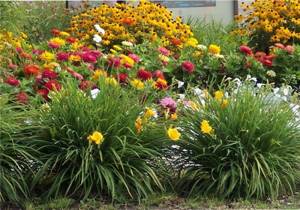
Daylilies will delight you with their luxurious appearance all season long if you choose varieties so that flowering lasts as long as possible and the lilies themselves do not shade each other. Typically, the tallest and late-blooming plants are placed in the background, with medium and low varieties that bloom early are planted in front of them.
The first to bloom are hybrids belonging to Longiflorum asiatica, whose flowering lasts from late May to mid-June. The following varieties are popular:
- “double whiskey” orange color;
- "glow" - bright yellow lilies;
- "coral fashion" with red petals.
After these plants bloom, the Asian hybrids will open their petals. They will delight gardeners until mid-July. Among these colors stand out:
- “Vengard” orange-gold shade;
- “Rostani” is light orange in color.
The next species to bloom are those belonging to the Orléans and Trumpet. Their representatives are:
- Russian variety “Snow Waltz”, distinguished by its pure white color;
- Pink Perfection and Bright Star plants with unique two-color petals.
At the very end of the flowering period, flowers belonging to oriental hybrids will open. They are represented by such famous varieties as “Time Out” and “Saint Point”.
Breeders have developed many varieties of the plant, each of which has its own unique beauty. Separately, you can have snow-white flowers of ideal proportions. Among the Asian representatives of the species, the most popular are white flowers of the “Candidum” variety and pink lilies of the “Dorama” variety.
Schemes and options for planting lilies at the club and at the dacha in the garden
Plants in the flowerbed do not require additional care and are very unpretentious to growing conditions. Asian lilies will become a bright accent in a flower arrangement. To implement this planting option, you will need a flowerbed 2.4 x 5 m.

Flowers planted at the dacha according to this scheme will not close even on the hottest day.
1 square in the diagram is equal to a square of 30 x 30 cm. The following plants are used:
- A. Dahlia dahlias, pink hybrid, 12 pcs.;
- B. Dahlia dahlias, red hybrid, 3 pcs.;
- C. Speedwell Sunny Border Blue, 3 pcs.;
- D. Dahlia dahlias, yellow hybrid, 3 pcs.;
- E. Asiatic lilies Landini, 10 pcs.;
- F. Asiatic lilies Sunny Crown, 10 pcs.;
- G. Boltonia astoriforme Snowbank, 2 pcs.;
- H. Penstemon Aetonii, 5 pieces;
- I. Purple moth Caerulea Arundinacea, 3 pcs.
Dahlias (A, B, C) will need to be dug up before the onset of cold weather and stored in the basement or in the bottom drawer of the refrigerator.

The remaining plants will easily survive the winter if they are provided with shelter.
Another way of laying out a flower bed with lily plants, which this time are adjacent to nasturtium and lobelia, requires a flower bed of 2.7 x 3.4 m.

Scale: the square in the diagram is equal to an area of 30 x 30 cm.
Plants in the diagram:
- A. Lobelia erinus, 3 pcs.;
- B. May nasturtium (Tropaeolum majus), 5 pcs.;
- S. Lily Star Gazer, 5 pcs.;
- D. Daylily Hemerocallis, 2 pcs.

Example of planting lilies
Beautiful circular composition with lily plants in the foreground. Plants bloom in July and will delight you with their beauty until autumn.

Circular planting
When planting lilies in tiers without the use of other plants, the following strip patterns are used:
- One-line. The distance between the holes for the bulbs should be 5-15 cm. The space between the lines is 50 cm.
- Two-line. The best option for medium-growing varieties. The holes are placed at a distance of 15-25 cm. At least 25 cm is left between the “lines”. Between the ribbons of two lines, the gap should be about 70 cm.
- Three-line. Suitable for low varieties and daylilies. The fit is the same as with the two-line tape pattern, but the gap between the holes is 15 cm.
The combination of lilies and Siebold hosta is loved by gardeners for their decorativeness and harmony.
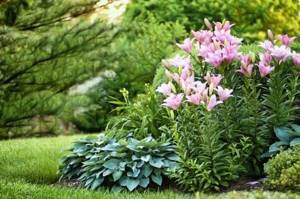
This game of contrast is used when creating flower arrangements in any location.
Another simple, but effective and elegant scheme for planting lilies with ornamental plants:
- Hosta Siebold (Hosta sieboldiana);
- hybrid daylily (Hemerocallis x hybrida Golden Orchid);
- Astilbe Arends (Astilbe x aaiendsii Federsee).
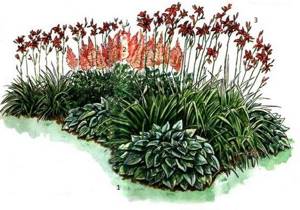
Planting scheme with ornamental plants
The same plants, but supplemented with blue-blue flowers and decorative ferns:

Planting scheme with fern
It will also be interesting: When to replant lilies - after flowering, to another place, in autumn or spring ⚜
Zinnias in landscape design

Zinnias are valued by flower growers and designers for their versatility. These flowers can be used for planting in various flower arrangements, as well as for decorating green spaces.
Low zinnias are great for borders and for growing in containers on the balcony. They are actively used in creating flower beds and alpine slides. Brightly colored plants create a wonderful contrast for green spaces such as hop shoots. If zinnias are planted around tall dahlia bushes, they will highlight the center of the composition. Flower beds made up of annual and perennial varieties allow you to get magnificent flowering throughout the summer.

Planting lilies in flowerbeds and borders
In an area with straight paths, you can beautifully plant lilies, emphasizing the overall atmosphere and direction of the design. It is especially important to decorate the path on both sides that directly leads to the house. The composition of flowers that accompanies from the gate to the front door greatly influences the perception of the entire design as a whole. The lily aroma, mixed with morning freshness, will give a romantic mood for the whole day.
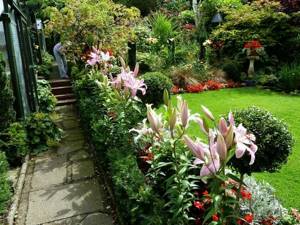
A photo of flowers located along the path to the porch demonstrates the sophistication and lightness of the composition.
For planting along the path and decorating low roadside hedges, trumpet lilies and the Harrisii species (L. Harrisii Hort) up to 80 cm high, which blooms in early summer with snow-white large flowers, are best suited.

Lilies along the path
Also suitable is the narrow-tubular white Price lily (Lilium formosanum), which is also known as Formosa or Taiwanese (height 60-90 cm). But it is best to border the paths and also complement the compact Thunberg (Lilium thunbergii) and Tiger (Lilium tigrinum) ridges.

They reach a height of up to half a meter and bloom from May to June with bright orange flowers with dark splashes.
Another species that can successfully decorate the lower tier of flower beds or decorate alpine hills is a drooping variety 40-60 cm high with pink-lilac turban-shaped flowers.
Lily varieties for single plantings
The lily itself is very beautiful: many of its varieties have large, brightly colored flowers and tall, straight stems with dense foliage. Therefore, it is often planted alone in order to concentrate attention only on this flower. Another type of monoplanting is planting a group of identical lilies and tying them to one support. This method is suitable for tall varieties that grow more than 120 cm in height.
Flowers can be planted in flowerpots. This will allow you to move them indoors for the winter.

At the same time, you can collect them into a neat “bouquet”.
You can also leave them to grow naturally - slightly bent under the weight of a large flower.
The following varieties of plants are most suitable for growing on your own:
- Golden (Lilium Auratum, Liliaceae);
- White, Candidum or Madonna flower (Lilium Candidum);
- Tiger (Lílium Lancifólium);
- Turban (Martagon Lily).
There is no point in surrounding some hybrids, for example, the Marlene lily, with other flowers, because no one will notice them next to such a beautiful flower. Under good care conditions, dozens of incredibly graceful flowers will crown a powerful stem a meter high.
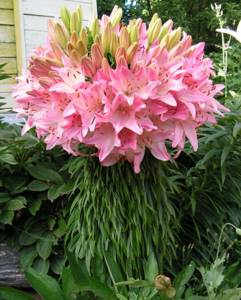
Lilia Marlene
More compact ornamental plants are also suitable for single plantings. For example, indoor varieties of lilies, planted in the garden for the summer, look very nice. It is not recommended to plant anything next to them, so as not to harm the flower, which has been pampered by home care.

And perhaps the best option would be to simply display it in a flower pot.
Can lilies and tulips be planted side by side? Flowers in a flowerbed: proximity and compatibility

It’s enough to buy flower seeds or flower bulbs, choose a color scheme, take into account the flowers’ requirements for humidity, light and soil quality – and that’s all? In reality, everything is a little more complicated. Neighbors should be selected carefully and taking into account their compatibility. We have already written about the compatibility of vegetable crops, now let’s talk about how to properly plant flowers in a flowerbed so that everyone is comfortable. Often, over time, plants push their neighbors out of the territory, and sometimes this happens completely unexpectedly and inexplicably. Let's not learn from mistakes, but rather do everything right right away when planting flowers.

It happens that plants with similar comfort requirements simply do not grow nearby. This applies to tree peonies. They are bad neighbors for perennials. Also, you should not plant peonies closer than 1.5 meters to shrubs and trees.
Plant roses away from cloves and mignonette. And peonies near a rose will depress it, so place them at a great distance from each other. Lilies of the valley will cause suffering to violets and peonies growing nearby. And dahlias have been proven to destroy almost all competitors. Please note that there are always fewer weeds next to dahlias.

The large family of buttercups, which includes more than 50 genera and 2000 species, deserves special attention. A large number of buttercups in a flowerbed will suck moisture and all useful elements from the soil, depleting the soil and leaving neighbors starving. The roots of buttercups secrete substances that can poison the lives of all plants nearby. With buttercups nearby, even hardy clover will die. Bulbous plants, which overwinter in the ground, can especially suffer from buttercups. In the spring, they have virtually no chance of breaking through the powerful interweaving of buttercup roots.
If you still want to plant bulbous and ranunculus plants on the same club, protect them from each other. This can be done using tin or metal frames, and place them both above the ground and in the ground.
How to choose plants for a flower bed?
Let's start with those that are not recommended to be planted nearby.
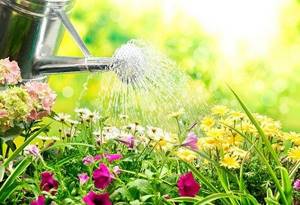
- Tulips and lilies are affected and damaged by the same diseases and pests. It is not advisable to plant them next to each other and replace each other. Places for planting them should be in different corners of the garden.
- Peonies and violets will feel uncomfortable if lilies of the valley grow next to them.
- Carnation, rose, mignonette. You should not plant roses next to carnations and mignonette. In this case, the rose acts as an oppressor for mignonette and cloves.
- Violets and sweet peas. Peas will depress the violet and will not allow it to grow fully.
And this is a list of good neighbors. Growing nearby, these flowers will create good development conditions for neighbors and protect each other from pests and diseases.

- Marigolds, roses and gladioli. Marigolds are known to repel pests. They are also recommended to be planted in vegetable beds. The proximity to roses and gladioli will have a good effect on these plants.
- Nasturtium and peony are a good neighbor. Nasturtiums growing next to a peony will protect it from fungal diseases and nematodes.
- Roses, phlox, marigolds. Marigolds protect neighbors well from nematodes. Phlox and roses, for which this disease is typical, under the protection of marigolds, will get rid of the risk of damage by nematodes.
- Asters and petunias living in the same flower garden will never get fusarium.
- Phlox and asters. Phlox secrete substances that protect against fusarium, so they are excellent precursors for asters.
- Asters and nasturtiums are good neighbors, since nasturtiums prevent the appearance of fusarium in asters.
- Lilies, roses, clematis are good neighbors. Clematis and lilies will protect roses from pests and diseases and promote the growth of rose bushes.
- Lavender and roses. Plant lavender around your roses; it will protect your garden queens from aphids.
Lilies on the lawns
Open, sunny lawns are suitable for trumpet, Asiatic and oriental lilies. The color of the flowering is selected so that it contrasts with the lawn grass:
- To create a bright and dynamic composition, red and yellow varieties are planted.
- To create a fresh and delicate picture, preference is given to pale pink and pastel purple colors.
- The effect of classics and elegance will be achieved by combining greenery with purple and white lilies.
To place a lily bed in an open space, you need to make a slight elevation. This will ensure good soil drainage and allow for interesting, creative solutions.
In open areas there should be no blowing cold winds and high groundwater. In the first case, you will need to plant shrubs or trees that will shelter the lilies from the wind. You can also build a decorative wall and cover it with climbing plants. In the second case, the flowerbed needs to be raised above ground level by constructing a pedestal that will ensure the dryness of the roots and bulbs.
Lawns with paths can be decorated with compact OT-hybrid bushes. The choice of varieties allows you to bring any colorful idea to life.
It will also be interesting: Lilies have bloomed - what to do next, caring for plants in August and September ⚜
What flowers to plant lilies with
Lilies should not be planted next to other flowers blooming at the same time. When planted together, they should have different flowering times. That is why designers do not recommend placing lilies next to roses. This will create competition for attention and make the landscape picture heavier. Experts advise planting lilies only with those plants with which they are combined:
- Peony. Despite the large and bright flower, this plant is ideal for proximity to lilies. It blooms earlier, and after flowering remains decorative enough to become a good green background for a lily plant, a support for its stem and a shelter for a faded peduncle.
- Iris. Suitable for the same reason as peony. But at the same time, you need to choose varieties that match the care requirements of lilies.
- Juniper, thuja and other coniferous and deciduous trees and shrubs. But the foliage should be one color. It is better not to experiment with variegated species without proper experience.
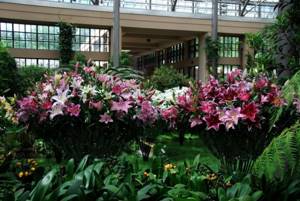
It is advisable that the trees do not bloom at the same time as the lilies.
- Flowers with small white flowers, provided that the lilies themselves are colored. The most suitable are: white alyssum, iberis and lavender. Of the tall species, lilies go well with blue-blue delphiniums. With enough experience, you can grow an elegant eustoma next to the lily.
- Ferns. These plants look most impressive with white flowers.
- Barberry and rhododendron are suitable for planting with yellow varieties.
Hostas that go well with lilies have a slight conflict with them regarding lighting. Variegated species grow well in bright light, while blue-green hostas prefer partial shade. Therefore, you need to have a certain level of professionalism in order to reconcile this contradiction and find a place that satisfies both plants.
What kind of neighborhood will lilies not tolerate?
When choosing which flowers can be planted next to lilies, remember: the latter will not feel comfortable with every plant. There are some specimens that, for one reason or another, cannot coexist with fragrant garden beauties.
- Hydrangeas prefer highly acidic soils for growth, while lilies grow on slightly acidic soil substrates.
- Irises bloom earlier than lilies or both plants bloom at the same time. After the flowering period ends, irises do not require watering, but lilies do.
- Tulips - their flowering period begins early and after it you need to dig up the bulbs. If the bulbs are close together, in the process of digging them up, there is a danger of damaging the root system of the lilies - this can happen at the moment when they bloom. Tulips and lilies are prone to the same diseases. In addition, tulip bulbs attract the attention of mice, which can also damage lily bulbs.
- Dahlias - flowers do not visually match each other. Dahlias have a developed root system, love abundant watering and actively take moisture from the soil, competing with lilies. Lilies do not tolerate waterlogged soil.
The best types and varieties of lilies for landscape design
Not every variety can be grown in open ground while maintaining its decorative qualities and health. The choice depends on the appearance of the flower and its ability to adapt to weather conditions and soil characteristics:
- The Madonna flower is popular all over the world - a white lily, a tall perennial that grows up to one and a half meters. It looks ideal in the center of the composition, covered from below by low plants, since the lower part of the flower is not particularly decorative.
- Tubular lilies are no less famous and loved by gardeners. Royal and Chinese varieties are the most common in landscape design. The Sargent lily can also be included in this category.
- The beauty and enchanting aroma of oriental varieties have gained legendary fame, but growing them in open ground is extremely difficult. They react painfully to both cold and heat. A way out of this situation was found when it was possible to cross trumpet and oriental lilies. As a result, we got an OT hybrid, beautiful like the orientals and persistent like the tubular varieties, but blooming only in the second year.
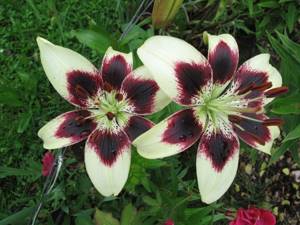
Asian hybrid
- It is worth noting such a variety as Belamkanda. It is distinguished by an interesting leopard print pattern on bright orange petals, for which it was named Leopard Lily. This beautiful and delicate flower does not tolerate winter cold and requires transplanting indoors for the winter. But admirers of its unusual appearance are prepared for the difficulties of transplanting and caring for the capricious variety so that it sets the tone for the design of the site.
It will also be interesting: When to prune lilies - after flowering, for the winter and whether it is necessary ✂
Is it possible to plant different varieties of lilies next to each other? Is it possible to plant lilies next to different varieties?
Other posts about lilies
Growing lily seedlings was a necessary measure after the lily I planted was pecked at by crows and it began to rot. Lily seedlings 'Twinkle' I brought the dug up damaged bulb home, divided it into scales, removed all the rotten ones...
Hello! I know that the usual time for planting lilies is autumn. Please tell me, can I plant lilies now if I bought fresh bulbs, sprouted and with a good root system? Or is this only possible on the balcony?
Hello. In the conditions of Surgut, is it necessary to germinate lilies in pots on a windowsill, like gladioli, or plant them directly in the soil? We usually plant everything at the end of May, beginning of June, when the soil warms up. Will they have time to bloom without germination?
Tell me when it is better to divide the nests of lilies - in the spring, as soon as sprouts appear, or at the end of summer after the end of flowering. Lilies grow in one place for 3 years. Location - southwest of the Moscow region. Thank you
Hello. There are lilies growing at home and we are planning to plant them in open ground in the spring. Tell me how to care for lilies until spring? And how to plant them correctly in the spring?











